A Deep Sea Squid Cares For Her Eggs

A Deep Sea Squid Cares for Her Eggs
In recent years, submersibles have allowed scientists to explore the lives of deep-sea animals in ways that were not possible before. One of the many exciting discoveries was that a mother of the deep-sea squid species Gonatus onyx broods her eggs by holding them in her arms, a behavior that had never been previously reported for squids.
This shocking discovery was the first time scientists had evidence of parental care in squids. In 2012, a team of researchers led by Stephanie Bush, reported finding another species of deep-sea squid that broods eggs, Bathyteuthis berryi, suggesting that this form of parental care may be a common solution to a reproductive problem for deep-sea squids.
Watch a video about this amazing deep-sea discovery:
http://ow.ly/ZS9jc
(via: Monterey Bay Aquarium Research Institute)
More Posts from Llamaslikesciencetoo and Others

Sawfish sharks,of the order (Pristiformes) of rays characterized by a long, narrow, flattened rostrum, or nose extension, lined with sharp transverse teeth, arranged so as to resemble a saw. All species of sawfish are endangered or critically endangered due to over fishing or habitat loss.
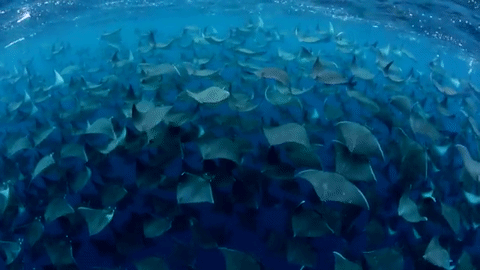
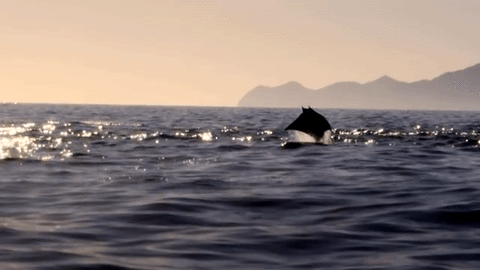
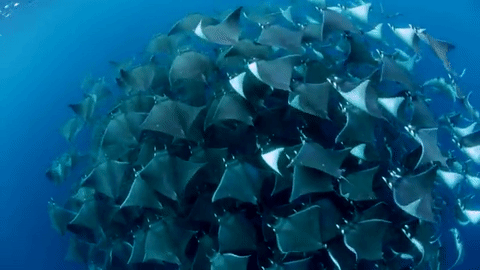

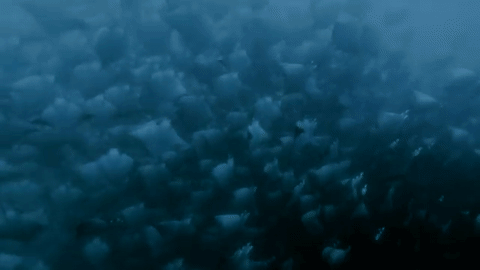
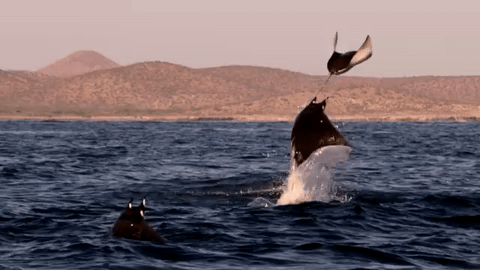
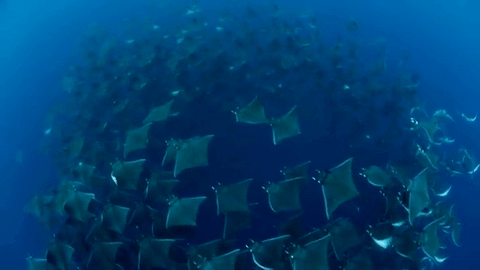
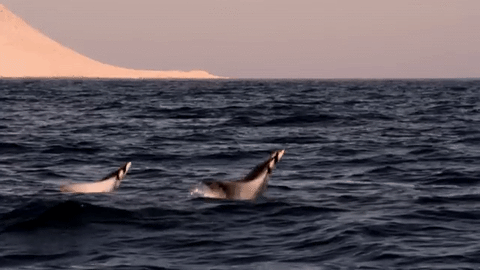
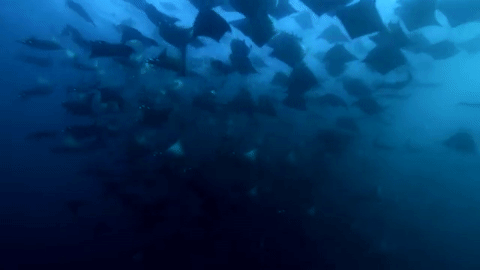
closely related to sharks but with long, flat bodies and wing-like pectoral fins, mobula rays are ideally suited to swooping through the water - here off the gulf of california - yet seem equally at home in the air, so much so that they have earned the name “flying rays”. mobula rays can reach heights of more than two metres, remaining airborne for several seconds.
mobula rays are quite elusive and difficult to study, so biologists are not quite sure why they jump out of the water. theories vary from a means of communication, to a mating ritual (though both males and females jump), or as a way to shed themselves of parasites. they could also be jumping as a way of better corralling their pray, as seen with them swimming in a circular formation.
what is known about mobula rays is that they reach sexual maturity late and their investment in their offspring is more akin to mammals than other fishes, usually producing just a single pup after long pregnancies, all of which makes them extremely vulnerable to commercial fishing, especially as a species that likes to come together in large groups.
How do you disentangle a humpback whale?
Very, very carefully – and without getting in the water. The Hawaiian Islands Large Whale Entanglement Response Network has it down to a science.

Photo: J. Moore/NOAA Permit #15240
Each year, numerous whales and other marine animals become entangled in a variety of materials, such as fishing gear, rope and plastic bags. Entanglement can physically harm animals while also impairing their movement. An entangled animal can find it difficult or impossible to feed, and at times the entanglement can drown them.
That’s where the Hawaiian Islands Large Whale Entanglement Response Network comes in. These highly-trained professionals from Hawaiian Islands Humpback Whale National Marine Sanctuary, working closely with and under authority of NOAA Fisheries’ Marine Mammal Health and Stranding Response Program, know how to safely rescue creatures like humpback whales from entanglement.

Humpback whales can hold their breath for much longer and swim faster than a human can, and an entangled whale is often stressed or panicked. Trying to free a 40-ton whale that likely doesn’t realize rescuers are there to help can be dangerous for the animal and for humans. Rescuers never enter the water to free an entangled whale.
Instead, rescuers grab hold of the entangled lines using a grappling hook, then attach a series of buoys to the lines. This keeps the whale at the surface and slows it down enough for the disentanglement team, following the whale in a small inflatable boat, to gain access to the animal and the lines it’s tangled in. However, even with the buoys attached, the inflatable boat may still get towed behind the animal. Humpback whales are strong animals that can move rapidly through the water, so this can be quite dangerous. It is important that the disentanglement team be trained and prepared to respond to the whale’s movements.

As the whale grows tired, the rescuers work their way closer. Once they’re close enough, they use a custom-designed knife attached to a long pole to cut away the gear entangling the whale. These knives are specially designed to cut the rope but not the whale. Typically, after several passes, the whale is free!
Once the whale is untangled, the team uses the grappling hook once again to collect and remove the debris from the water so that other animals don’t become trapped in the future.

Photo: Ed Lyman/NOAA, under NOAA permit #15240
Entanglement is a problem around the globe, and sanctuary staff can only help a small percentage of entangled whales. Since 2002, Hawaiian Islands Humpback Whale National Marine Sanctuary has received more than 100 confirmed reports of entangled humpbacks, representing at least 70 different animals — and more entanglements go unseen and unreported.
With that in mind, prevention is the ultimate objective: by reducing the amount of derelict fishing gear and other debris in the ocean and making actively fished gear more “whale safe,” we can reduce the number of whales and other animals that get entangled and hurt or killed.
Watch the Disentanglement Response Network in action:
GIFs via NOAA’s Marine Mammal Health and Stranding Response Program, under NOAA permits 932-1905, 15240 932-1489, and 932-1905-01/MA-009526-1, and Hawaii State Permit PMAL-2015-206.


The tardigrade genome has been sequenced, and it has the most foreign DNA of any animal
Scientists have sequenced the entire genome of the tardigrade, AKA the water bear, for the first time. And it turns out that this weird little creature has the most foreign genes of any animal studied so far – or to put it another way, roughly one-sixth of the tardigrade’s genome was stolen from other species. We have to admit, we’re kinda not surprised.
A little background here for those who aren’t familiar with the strangeness that is the tardigrade – the microscopic water creature grows to just over 1 mm on average, and is the only animal that can survive in the harsh environment of space. It can also withstand temperatures from just above absolute zero to well above the boiling point of water, can cope with ridiculous amounts of pressure and radiation, and can live for more than 10 years without food or water. Basically, it’s nearly impossible to kill, and now scientists have shown that its DNA is just as bizarre as it is.
So what’s foreign DNA and why does it matter that tardigrades have so much of it? The term refers to genes that have come from another organism via a process known as horizontal gene transfer, as opposed to being passed down through traditional reproduction.
Horizontal gene transfer occurs in humans and other animals occasionally, usually as a result of gene swapping with viruses, but to put it into perspective, most animals have less than 1 percent of their genome made up of foreign DNA. Before this, the rotifer – another microscopic water creature – was believed to have the most foreign genes of any animal, with 8 or 9 percent.
But the new research has shown that approximately 6,000 of the tardigrade’s genes come from foreign species, which equates to around 17.5 percent.
“We had no idea that an animal genome could be composed of so much foreign DNA,” said study co-author Bob Goldstein, from the University of North Carolina at Chapel Hill. “We knew many animals acquire foreign genes, but we had no idea that it happens to this degree.”
Continue Reading.

laser-free diet.

Untitled by twyscape

Sharks are fucking metal!

7 types of fog you didn’t know had names
Fog comes in several distinct varieties that are influenced by nearby bodies of water, landscape features and other local factors. Here are some of the most impressive forms of it on the planet.
70 Ask-Questions for Science people... because Science
What’s your major/field?
What made you choose your major/field?
What’s your favorite thing to do in the lab?
What’s the most interesting lab story?
What’s your favorite class?
Which professors do you ship together?
Annoying things your labmates do?
What are your thoughts on animal testing?
Any chemical burns or lab related accidents?
On a scale from 1 to 10 how sensitive are your lab scales?
Who’s your favorite scientist?
Who’s your least favorite scientist?
Favorite female scientists?
Do you do field work? What kind?
Ever tasted an experiment?
What are your typical daydreams about?
How often do you say “for science”?
Do you think about murdering someone with science?
Ever used your scientific knowledge for “bad” stuff?
Whats the most “evil scientist” thing you can think of?
If you had infinite funding, what would your research be about?
What is your favorite scientific theory?
Is a scientific mind attractive to you?
What is your title?
What is the role of technology in your field?
What do you enjoy most about doing science?
What do you enjoy least about doing science?
What is your tolerance on stupidity?
What are your strengths in your field of study?
Your weaknesses?
Do you have a bit of a god complex?
Why are biology majors so….you know..
What motivates you?
Do you like being supervised?
Describe your analytic abilities.
How would your friends describe you?
How would your professors describe you?
Is math a little bit too mathy for you?
Do you code? if yes, how many languages?
Thoughts on AI and robots?
What’s your favorite science blog?
Philosophical views on humanity and nature?
What are your short term and long term career goals?
Do you understand general relativity?
Favorite Dinosaur? Fossil? whatever…
How many bones can you name in medical terms?
How many muscles can you name in medical terms?
What’s your favorite molecule?
Do you like proofs or cold hard Mathematics?
What’s your favorite element?
Favorite show?
Favorite scientific fictional character?
What’s your favorite micro organism?
Have you ever held an organ in your hands?
Lab coats?
What about … lab goats?
White latex gloves or blue ones?
What’s the most dangerous experiment you’ve done in the lab?
What was the first time you got caught doing science?
What was you’r parent’s reaction when you told them you’re a scientist?
Except for lab coats in the bedroom what other kinks do you have?
What would you do a TED talk on?
Are you creative, artistic?
Do you have an attractive professor you can’t pay attention to?
What’s your favorite mineral?
What scientific books would you recommend?
Thoughts on spectral analysis?
Any interesting stories from the lab?
Ever did or thought about doing it or someone in the lab?
How much science is too much science?
Compiled by: rudescience

Plate 12. Jellies. Histoire naturelle des zoophytes. Acalèphes. 1843.
-
 vintage-squid reblogged this · 1 year ago
vintage-squid reblogged this · 1 year ago -
 ginger-and-lemon reblogged this · 2 years ago
ginger-and-lemon reblogged this · 2 years ago -
 aging-walnut liked this · 2 years ago
aging-walnut liked this · 2 years ago -
 uniquepickles reblogged this · 2 years ago
uniquepickles reblogged this · 2 years ago -
 lugiavsfossilfuels liked this · 3 years ago
lugiavsfossilfuels liked this · 3 years ago -
 terrakionn liked this · 5 years ago
terrakionn liked this · 5 years ago -
 radiumkind liked this · 6 years ago
radiumkind liked this · 6 years ago -
 andiamstillfuckingaround reblogged this · 6 years ago
andiamstillfuckingaround reblogged this · 6 years ago -
 savannah66678 liked this · 6 years ago
savannah66678 liked this · 6 years ago -
 brachyurans reblogged this · 6 years ago
brachyurans reblogged this · 6 years ago -
 afterbrainscan reblogged this · 7 years ago
afterbrainscan reblogged this · 7 years ago -
 creaturedeityendless liked this · 8 years ago
creaturedeityendless liked this · 8 years ago -
 keithsstupidmullet liked this · 8 years ago
keithsstupidmullet liked this · 8 years ago -
 burning-down-the-walls reblogged this · 8 years ago
burning-down-the-walls reblogged this · 8 years ago -
 marsupial-soupkitchen-blog liked this · 8 years ago
marsupial-soupkitchen-blog liked this · 8 years ago -
 mikepents liked this · 8 years ago
mikepents liked this · 8 years ago -
 momma-crow reblogged this · 8 years ago
momma-crow reblogged this · 8 years ago -
 bombcollar liked this · 8 years ago
bombcollar liked this · 8 years ago -
 lindwyrm liked this · 8 years ago
lindwyrm liked this · 8 years ago -
 windmill-ghost reblogged this · 8 years ago
windmill-ghost reblogged this · 8 years ago -
 shift-ocean-blog reblogged this · 8 years ago
shift-ocean-blog reblogged this · 8 years ago -
 lazy-shy-weird-cat reblogged this · 8 years ago
lazy-shy-weird-cat reblogged this · 8 years ago -
 crabhaven liked this · 8 years ago
crabhaven liked this · 8 years ago -
 noonelovesmelikeiloveme reblogged this · 8 years ago
noonelovesmelikeiloveme reblogged this · 8 years ago -
 hopehedgehog liked this · 8 years ago
hopehedgehog liked this · 8 years ago -
 scummyflowers reblogged this · 8 years ago
scummyflowers reblogged this · 8 years ago -
 caitsylph reblogged this · 8 years ago
caitsylph reblogged this · 8 years ago -
 spook-wolf liked this · 8 years ago
spook-wolf liked this · 8 years ago -
 spook-wolf reblogged this · 8 years ago
spook-wolf reblogged this · 8 years ago -
 queenofthebuckets liked this · 8 years ago
queenofthebuckets liked this · 8 years ago -
 secret-of-maana liked this · 8 years ago
secret-of-maana liked this · 8 years ago -
 malacologiacalifornia-blog reblogged this · 8 years ago
malacologiacalifornia-blog reblogged this · 8 years ago -
 blukiwi reblogged this · 8 years ago
blukiwi reblogged this · 8 years ago -
 blukiwi liked this · 8 years ago
blukiwi liked this · 8 years ago -
 animegirl996 liked this · 8 years ago
animegirl996 liked this · 8 years ago -
 fluffythecthulhu liked this · 8 years ago
fluffythecthulhu liked this · 8 years ago -
 theokid liked this · 8 years ago
theokid liked this · 8 years ago -
 liberator-drana liked this · 8 years ago
liberator-drana liked this · 8 years ago -
 shadefish reblogged this · 8 years ago
shadefish reblogged this · 8 years ago -
 shadefish liked this · 8 years ago
shadefish liked this · 8 years ago -
 bored-of-stupidity reblogged this · 8 years ago
bored-of-stupidity reblogged this · 8 years ago -
 bored-of-stupidity liked this · 8 years ago
bored-of-stupidity liked this · 8 years ago -
 1veryskepticalgecko reblogged this · 8 years ago
1veryskepticalgecko reblogged this · 8 years ago -
 batsghoulsandghosties liked this · 8 years ago
batsghoulsandghosties liked this · 8 years ago -
 processormalfunction liked this · 8 years ago
processormalfunction liked this · 8 years ago -
 bloodredx reblogged this · 8 years ago
bloodredx reblogged this · 8 years ago
Mainly interested in ecology, but also the entirety of science.
179 posts